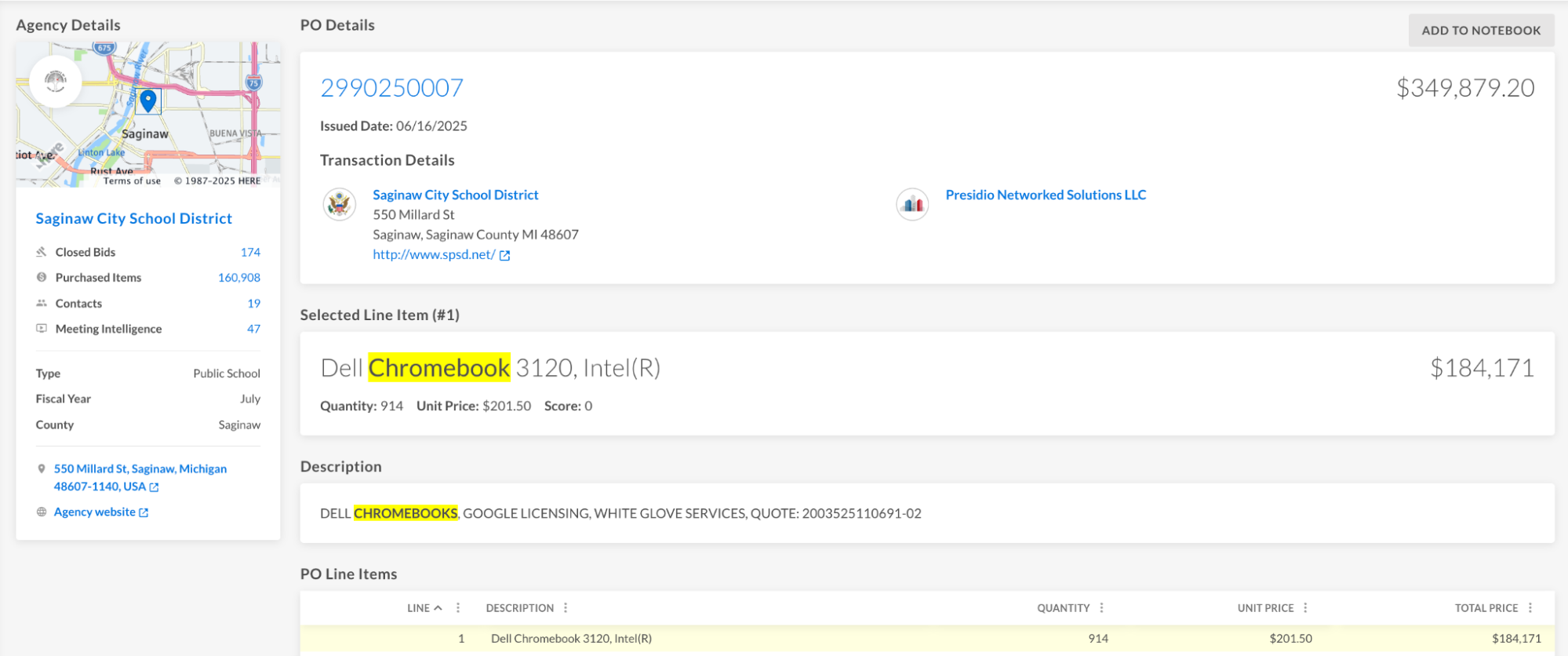
It’s officially crunch time for K-12 budgets.
Most school districts across the country start Fiscal Year 2026 on July 1, 2025—and right now, administrators are finalizing what goes in (and what gets cut). If you wait for an RFQ or RFP to hit your inbox, you’re already behind.
The good news? GovSpend gives you the tools to see what’s coming—and position yourself to win—before the bid ever drops.
Here’s how vendors selling to K-12 schools can use the GovSpend platform to get ahead of FY2026 and take a proactive, data-driven approach to growing their pipeline.
1. Start with the Budget Conversations
Every big purchase starts with a conversation, usually in a school board meeting. GovSpend’s Meeting Intelligence module lets you search public transcripts from school boards nationwide. Start by entering terms like “budget,” “facility upgrade,” “learning management system,” “tech refresh,” or anything related to your product or service.
Then, listen in on meetings directly at the timestamp where your keywords are mentioned, or save even more time by letting our AI prompts analyze the meeting transcripts for you. With the click of a button, you can see a summary of what was discussed, future plans and funding, and who’s making the decisions. You can also utilize the chat feature to ask your own specific questions and dive deeper into the information most relevant to you.
Here are some examples of upcoming projects that were recently mentioned in K-12 meetings:
- On June 23, the Pleasant Valley School District (PA) discussed multiple future projects, including tennis court repairs, a new reading and math program for struggling middle and high schoolers, and adding a secured time clock and door access.
- On June 23, the Fall River School Committee (MA) had a conversation around allocating ARPA funds for the PACE Center, with a focus on completing the fire suppression system, as well as potentially wiring the CUS community room to livestream full committee meetings.
- On June 19, the Rockport-Fulton ISD school board (TX) shared 10 different grant opportunities that they are applying for or have been accepted for, including $718,000 towards supporting special education students, $44,000 to support Career and Technical Education, $100,000 that can be applied to the purchase of access control in video monitoring software, and $91,500 for student Chromebooks.

Having access to final budget discussions is like having a crystal ball—you know what school districts will be buying, when they plan on purchasing, and how much money they have to spend… all before a formal request is even written.
2. Review What They’ve Bought (and When, from Who…)
Understanding what a district has purchased in the past helps you predict what they’ll need next. You can use the Spending module to find what they bought, who they bought it from, when the purchase was made, and how much they spent.
Focus on purchases made 1–5 years ago—those products and services are often due for replacement or renewal. Things like technology and classroom equipment, curriculum and instructional materials, and software licensing may need updating every 3-5 years, but other purchases that are crucial for schools, such as fleet maintenance, safety equipment, and building infrastructure, typically need upgrades or inspections annually or even more frequently.
For example:
- Montgomery County Public Schools (MD) paid for their annual fire extinguisher inspection on October 29, 2024. They will need to be tested again by October 29, 2025.
- On July 6, 2022, Agora Cyber Charter School (PA) purchased 3-year laptop accident protection for 38 devices. This protection will be expiring on July 6 of this year.
- On October 15, 2020, Panama-Buena Vista Union School District (CA) spent $567,045.81 on the second year of a six-year Chromebook rental agreement. This means that their current rental period will be ending on October 15 of this year, and they will likely need to rent or purchase more Chromebooks.

Knowing who school districts previously purchased from, and how much they spent, helps you craft a more competitive offer.
3. Spot Contracts Coming Up for Renewal
Many school purchases are tied to contracts—and all contracts ultimately have an end date. In the Contracts module, you can search by product type or agency and filter by expiration date to see what’s coming up in the next 6–12 months. You’ll find information on awarded vendors, contract terms and pricing, renewal language, and key contacts. You can also use AI Chat and Prompts in Contracts to swiftly pull out the most relevant information.
Being aware of when a contract ends gives you a head start. You can introduce your solution well before the agency starts its next procurement cycle. To start targeting FY26 opportunities now, we recommend tracking contracts that end between July 2025 and March 2026, such as:
- Dallas ISD (TX)’s current grounds maintenance services contract ends on August 31 of this year. This contract does not auto-renew and can be re-evaluated by both parties each year.
- Baltimore County Public Schools (MD) has a 10-year contract expiring on October 31, 2025 for student analysis and boundary planning software, that has no mention of renewal options on the contract.
- Loudon County Public Schools (VA) has a contract for water treatment services that expires on February 28, 2026 and has 0/4 renewals remaining.

4. Use Buying Signals to Get In Early
Buying signals—like related purchases—can point you to districts that will likely need your product next. By searching in the Spending module, you can track purchases that indicate demand for your solution—even if it hasn’t been publicly announced yet.
For example:
- Saginaw City School District (MI) purchased 914 Chromebooks on June 16. To accompany this, they may need charging carts, software, and/or cases.
- Evergreen Park Elementary School District No. 124 (IL) bought 100 iPads on June 12. They will likely be looking for new applications or additional licenses for current software subscriptions.
- On January 13, Acton-Boxborough Regional School District (MA) paid for three new electric school buses. They will need regular maintenance of the buses, as well as electric charging units.

Make sure to save your searches and set up alerts so you’re notified the moment a qualifying transaction is logged.
5. Find the Right People, Right Away
Once you find an opportunity, it’s all about getting in touch with the right person. GovSpend’s Contacts module lets you zero in on decision-makers and the people who are actually using your products or services regularly, such as Directors of Technology, Purchasing Managers, Facilities Coordinators, Curriculum Leads, and IT or Operations staff. Filter by title, department, or agency and you’ll get access to their name, phone number, email, and department.
You can also quickly find the best contact within an agency using AI chat in the Meeting Intelligence and Contracts modules. After surfacing information about a potential opportunity, simply type in the chat, “Who should I contact about this?” If the POC was mentioned in the contract or during the meeting, you can head to the agency page and find that person in the contacts list.
For example, when asked who should be contacted about the new reading and math program discussed in Pleasant Valley School District’s meeting on June 23, AI chat was able to immediately surface that information from the transcript: Christine and Julie. From there, you can go to Pleasant Valley School District’s page, look at their contacts, and find Christine and Julie along with their direct contact information.

A quick tip to improve your outreach strategy is to tailor your message to the specific agency, referencing their past purchases or upcoming needs. It beats a generic cold email every time.
Don’t Wait—Act Before FY2026 Even Begins
As school districts finalize budgets, your window to get in early, build relationships, and influence decisions is open—but you must take action to stay ahead.
GovSpend makes it easy to:
- Track what school systems are planning
- Review what they’ve purchased
- See which contracts are expiring
- Get in front of the right decision-makers
Use our comprehensive data to build your FY26 strategy now, and you’ll be first to know when it’s time for K-12 agencies to buy.
Need help building saved searches or reports? Reach out to your GovSpend Relationship Manager or email support@govspend.com—our team is ready to help.
Interested in learning more about how the GovSpend platform can help your business be more efficient and competitive? Complete our demo request form to connect with one of our Sales team members.




